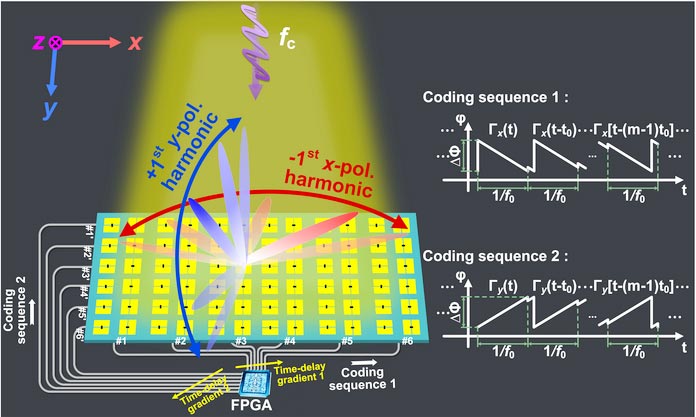
Space-Frequency Polarization Division for Enhanced Wireless Communication

The space-frequency-polarization-division multiplexed wireless communication system, which can modulate different information on different carrier frequencies with different polarization states, and transmit them through different space channels independently and simultaneously.
Credit: ©Science China Press
… makes wireless communications more powerful.
Since the concepts of digital coding metasurface and programmable metasurface were put forward in 2014, the physical world of electromagnetics has been closely connected to the digital world of information, thus producing unique advantages of metasurface-based wireless communications. In recent years, the proposal and development of time-domain coding metasurface (TDCM) and space-time-coding metasurface (STCM) have further enriched the electromagnetic modulation and digital process schemes and application scopes. However, most of metasurface-based wireless communication systems are only applicable for single-polarization scenarios, and the capacity of transmitted information is still limited.
In a new paper published in National Science Review, a team of scientists developed a frequency-polarization-division multiplexed wireless communication system and a space-frequency-polarization-division multiplexed wireless communication system based on anisotropic STCM. This study was led by Prof. Tie Jun Cui and Prof. Qiang Cheng at the State Key Laboratory of Millimeter Waves, and Prof. Shi Jin at the National Mobile Communications Research Laboratory, Southeast University.
The scientists designed a reflection-type polarization-independent phase-controllable anisotropic STCM. When the rows and columns of the anisotropic STCM are biased by different time-varying control voltage sequences, the frequency-polarization-division multiplexed modulation and the space-frequency-polarization-division multiplexed modulation can be realized respectively. On this basis, the scientists experimentally validated the real-time data transmission capabilities of the frequency-polarization-division and the space-frequency-polarization- division multiplexed wireless communication systems, which confirms the practicability of the proposed wireless communication architectures.
Firstly, the scientists converted two baseband signals into the linearly time-varying control voltage sequences with different slopes, respectively, and applied them to two polarization channels of the anisotropic STCM. In this way, two baseband signals can be modulated onto different polarization and harmonic frequency channels, realizing the frequency- polarization-division multiplexed modulation. Furthermore, by introducing different delay gradients into the control voltage sequences of two polarization channels, the harmonic beams in two polarization directions can be steered to specified directions respectively, thereby realizing the space-frequency-polarization-division multiplexed modulations (see the image below). For the experimental validations, these scientists summarized the results as follows:
“Firstly, we set up a frequency-polarization-division multiplexed wireless communication system in an indoor environment, and realize the independent and synchronous transmissions of two 480p resolution videos through this communication system. Subsequently, we set up a space-frequency-polarization-division multiplexed wireless communication system, and realize the independent and synchronous data transmissions towards two different specified directions.”
“Compared to the former metasurface-based wireless communication systems, our proposal improves the channel capacity and space utilization by using the space-frequency-polarization-division multiplexing, which provides low-cost and high-integration scheme for constructing the multiple-user collaborative wireless communication networks.” the scientists forecast.
See the article:
Space-frequency-polarization-division multiplexed wireless communication system using anisotropic space-time-coding digital metasurface
https://doi.org/10.1093/nsr/nwac225














